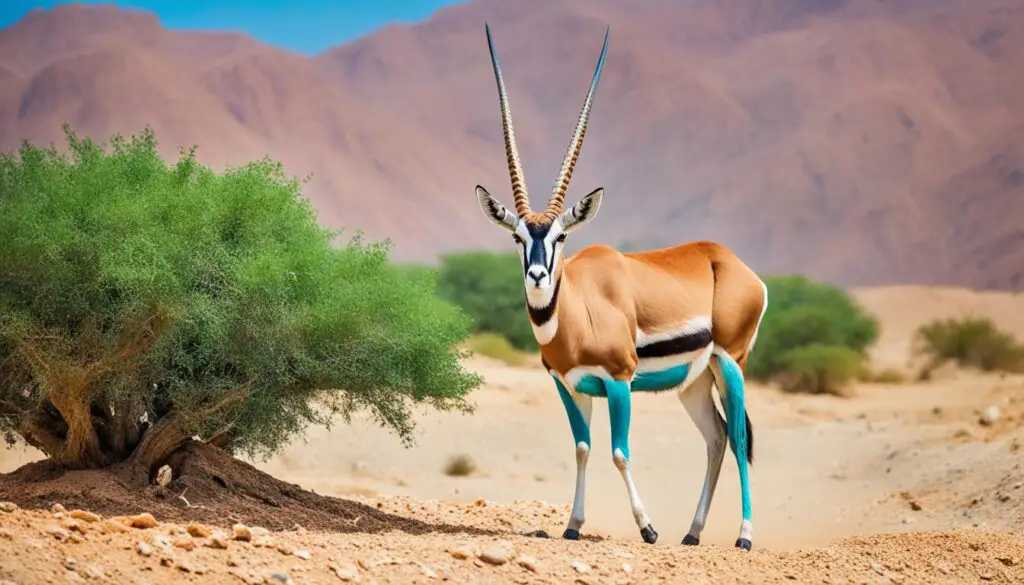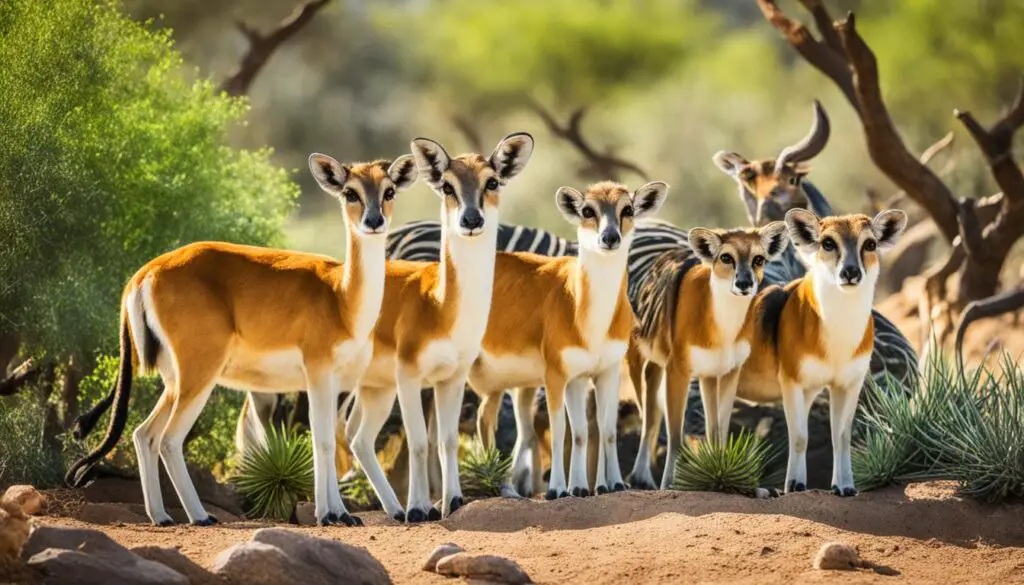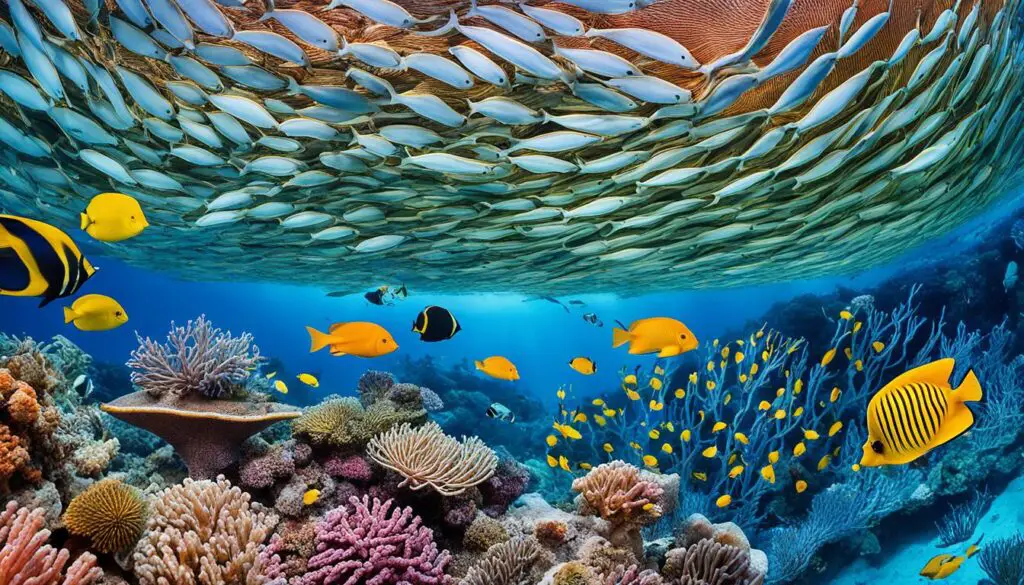Did you know that Oman is home to an incredible array of wildlife, including some of the rarest and most unique species in the world? With its diverse landscapes and rich biodiversity, this hidden gem on the southeastern corner of the Arabian Peninsula offers a wildlife experience like no other.

From the magnificent Arabian leopard to the majestic Arabian oryx, Oman is a haven for endemic species that are found nowhere else on earth. Its coastal waters teem with whales, dolphins, and sea turtles, while its deserts and mountains are inhabited by a wide range of mammals, birds, and reptiles.
Join us on a journey through the stunning habitats of Oman as we explore its remarkable fauna and the efforts being made to conserve and protect this natural heritage.
Key Takeaways:
- Oman is home to a diverse range of wildlife, including rare and endemic species.
- The country’s unique geographical features support a variety of habitats, from deserts to mountains and coastlines.
- Oman has implemented strict conservation measures to protect endangered species and preserve its rich biodiversity.
- Bird watching and marine life encounters are popular activities for nature enthusiasts in Oman.
- Visiting Oman provides an opportunity to experience the beauty and wonder of Arabian wildlife firsthand.
Biodiversity in Oman
Oman boasts a remarkable level of biodiversity, with a wide range of plant and animal species. The country is home to over 1,200 recorded plant species, 78 of which are endemic to Oman. The flora in Oman varies across different regions, showcasing desert shrubs in the interior plateau and lush vegetation during the rainy season in areas like Dhofar.
When it comes to fauna, Oman hosts a diverse array of wildlife. The rugged landscapes are inhabited by fascinating mammals such as the Arabian leopard, Arabian oryx, gazelles, and wild cats. These species have adapted to survive in the challenging desert environments and play a crucial role in maintaining the ecological balance of the region.
The seas surrounding Oman are also teeming with marine life. Whales, dolphins, and sea turtles thrive in these waters, adding to the country’s rich biodiversity. The conservation efforts in Oman aim to protect these fragile ecosystems and ensure the survival of these magnificent creatures for future generations.
Oman’s Endemic Plant Species
Oman’s endemic plant species are a testament to the country’s unique biodiversity. These plants have adapted to the specific environmental conditions of Oman, making them uniquely suited to thrive in the region. Here are a few examples of endemic plant species in Oman:
- Frankincense Tree (Boswellia sacra)
- Omani Fig (Ficus ingens)
- Oman Olive (Olea europaea subsp. laperrinei)
- Oman Ficus (Ficus cordata)
These endemic plant species play a vital role in maintaining the delicate balance of Oman’s ecosystems and have cultural and economic significance for the local communities.
Oman’s Diverse Wildlife
Oman is home to a wide variety of animal species, ranging from the majestic Arabian leopard to the graceful gazelles. Here are some notable examples of fauna in Oman:
| Animal | Habitat |
|---|---|
| Arabian Leopard | Mountainous regions |
| Arabian Oryx | Desert and semi-desert areas |
| Gazelles | Grasslands and desert areas |
| Wild Cats | Various habitats |
Oman’s diverse fauna is a testament to the country’s commitment to conservation and its efforts to protect and preserve the unique wildlife species that call it home. By safeguarding their habitats and implementing strict laws, Oman aims to secure a sustainable future for its remarkable biodiversity.
Wildlife Conservation in Oman
Oman has implemented strict laws to protect its wildlife, particularly endangered species like the Arabian leopard and Arabian oryx. The country recognizes the importance of preserving these iconic animals and has taken significant steps towards their conservation.
One of the key initiatives in wildlife conservation is the establishment of nature reserves throughout Oman. These reserves serve as protected areas where the natural habitats of endangered species are preserved. Currently, there are fifteen reserves in Oman, each with its own unique characteristics and objectives.
Safeguarding Biodiversity
The reserves in Oman play a crucial role in conserving biodiversity. They provide a safe haven for a wide range of flora and fauna, ensuring their survival for future generations. By protecting the natural ecosystems, these reserves help maintain the delicate balance of nature.
Notably, the Arabian leopard and Arabian oryx are two flagship species that are deeply intertwined with conservation efforts in Oman. These majestic creatures are considered national treasures and are symbolic of the country’s commitment to wildlife preservation.
Research and Education
In addition to conservation, the reserves also serve as centers for research and education. Scientists and researchers conduct studies to better understand the behavior, habitat requirements, and breeding patterns of various species. This knowledge is instrumental in formulating effective conservation strategies.
Furthermore, the reserves offer educational programs and activities for visitors, local communities, and students. These initiatives aim to raise awareness about the importance of wildlife conservation and foster a sense of responsibility towards the environment.
Supporting Ecotourism
Ecotourism plays a significant role in sustaining conservation efforts in Oman. The reserves attract visitors from around the world who have a deep appreciation for nature and wildlife. These tourists contribute to the local economy while also supporting conservation initiatives.
Visitors can immerse themselves in the natural beauty of Oman, experience its diverse wildlife firsthand, and learn about the importance of preserving these habitats. Ecotourism provides a sustainable means of generating revenue while ensuring the long-term protection of the country’s natural heritage.
Despite the ongoing challenges and conflicts with industries such as oil prospecting, the Omani government remains dedicated to wildlife conservation. By implementing strict laws, establishing nature reserves, conducting research, promoting education, and supporting ecotourism, Oman continues its relentless efforts to protect its unique biodiversity and ensure a sustainable future for its wildlife.

Bird Watching in Oman
Oman is a paradise for bird watchers, with over 500 species of birds recorded throughout the year. The country’s strategic location along bird migration routes attracts a wide variety of species, including resident birds, breeding birds, and migratory birds from the Palearctic realm, Africa, and the Indian Subcontinent.
From the mudflats and lagoons of the east coast to the desert areas and mountains, bird enthusiasts can spot waders, gulls, terns, eagles, vultures, and many other fascinating species. The Dhofar region in the south is particularly rich in breeding and migratory bird species.
Exploring Oman’s diverse habitats, bird watchers can witness the enchanting sight of migratory birds making their journey. The east coast provides a haven for shorebirds and waterbirds, with species like the curlew sandpiper, flamingos, and the magnificent greater flamingo. In the mountains, bird enthusiasts have the opportunity to observe raptors soaring through the skies, such as the Bonelli’s eagle and steppe eagle.
For those interested in waterbirds, the Barr Al Hikman nature reserve on the coast is a must-visit. This globally significant wetland is home to a plethora of bird species, including the iconic Socotra cormorant and the elegant crab plover. Visitors can witness the fascinating behaviors of these birds, such as their fishing and nesting rituals.
Oman Bird Species
Oman is home to a diverse range of bird species, both resident and migratory. Here are some notable bird species that can be spotted in Oman:
| Bird Species | Habitat |
|---|---|
| Arabian Partridge | Desert and mountain regions |
| Pale Crag Martin | Cliffs and rocky areas |
| Pied Avocet | Mudflats and salt pans |
| Sooty Falcon | Coastal areas and islands |
| Vinous-breasted Starling | Woodlands and gardens |
| Yellow-vented Bulbul | Urban and rural areas |
These are just a few examples of the incredible bird diversity that can be observed in Oman’s various ecosystems. Whether you are a seasoned bird watcher or a beginner, Oman offers an unforgettable experience for bird enthusiasts.
Marine Life in Oman
The pristine waters surrounding Oman are teeming with a diverse range of marine life, making it a paradise for nature enthusiasts and underwater adventurers. From magnificent whales to playful dolphins, Oman’s marine ecosystem offers a captivating experience for all who explore its depths. With over 22 recorded species of whales and dolphins, the sightings are abundant and awe-inspiring.

Oman’s coastline serves as a seasonal habitat and migration route for various cetaceans, including humpback whales, pygmy blue whales, and sperm whales. These majestic creatures can often be observed breaching and swimming gracefully through the pristine waters, providing an unforgettable encounter.
Marine Reserves in Oman
One of the most remarkable marine reserves in Oman is the Al Dimaniyat Islands Nature Reserve. Recognized as a UNESCO-protected area, this reserve offers exceptional opportunities for snorkeling and diving, allowing visitors to witness the vibrant marine ecosystem up close.
Exploring the underwater world of the Al Dimaniyat Islands reveals a stunning array of marine life. Snorkelers and divers will encounter breathtaking coral reefs, colorful reef fish, elusive moray eels, and even zebra sharks. The reserve’s unique ecosystem also serves as a nesting site for endangered hawksbill turtles, further highlighting its importance for conservation.
Aside from the Al Dimaniyat Islands, Oman boasts several other marine reserves and protected areas, each contributing to the preservation of its marine biodiversity. These reserves not only safeguard the habitat of marine creatures but also provide opportunities for scientific research and educational activities.
As an added bonus, Oman’s marine reserves are not only home to incredible marine life but also attract migratory birds. This convergence of land and sea creates a unique environment that supports a variety of wildlife and allows for memorable experiences for nature enthusiasts of all kinds.
The Underwater World Awaits
Embarking on a marine adventure in Oman is an opportunity to witness the wonders of the underwater world. Whether it’s encountering magnificent whales, swimming alongside playful dolphins, or exploring vibrant coral reefs, Oman’s marine life offers a captivating experience for everyone. By preserving its marine reserves and actively promoting conservation efforts, Oman continues to protect and celebrate its rich marine biodiversity for generations to come.
| Common Whales | Common Dolphins |
|---|---|
| Humpback Whale | Common Bottlenose Dolphin |
| Pygmy Blue Whale | Striped Dolphin |
| Sperm Whale | Spinner Dolphin |
Conclusion
Oman’s unique geography and climate make it a haven for a diverse range of wildlife, offering nature enthusiasts abundant opportunities to observe animals in their natural environment. With its deserts, mountains, coastlines, and marine reserves, Oman provides a varied and captivating landscape for wildlife exploration. The country’s commitment to conservation is evident through the establishment of nature reserves, ensuring the protection of endangered species and the preservation of Oman’s rich biodiversity.
From the mesmerizing bird species that migrate through Oman’s skies to the magnificent marine life that inhabits its waters, the country is a paradise for animal enthusiasts. The Arabian leopard, Arabian oryx, and other endemic species showcase the unique fauna of Oman, adding to the country’s allure. With a visit to Oman, one can embark on unforgettable experiences like bird watching, marine life encounters, and exploring magnificent landscapes teeming with animal life.
By valuing and safeguarding its natural heritage, Oman sets an example for biodiversity conservation. The country’s dedication to ecological preservation offers a promising outlook for the future of wildlife in Oman. The breathtaking encounters with animals and the opportunity to witness the delicate balance of nature make a visit to Oman an enriching and awe-inspiring experience for all who cherish the wonders of the natural world.
